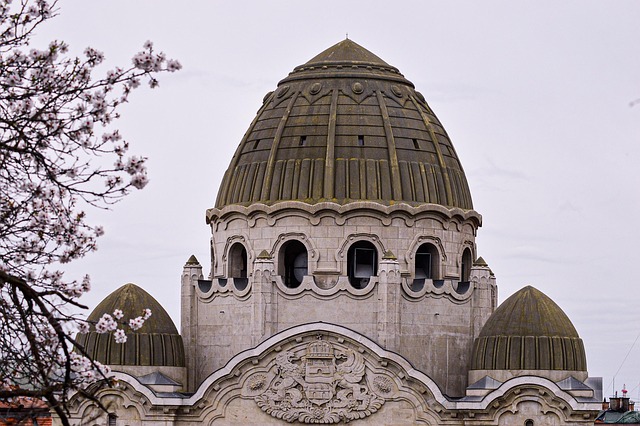Green roofing is a sustainable solution that transforms rooftops into ecosystems, offering improved energy efficiency, environmental benefits, and aesthetic appeal. Eco-friendly materials like plant-based options, recycled content insulants, and innovative products reduce carbon footprints and promote biodiversity. Proper installation and maintenance, including structural assessments, drainage layers, weeding, and native plant use, maximize thermal regulation and water retention. Global case studies demonstrate green roofing's potential to enhance ecological sustainability and achieve net-zero buildings through superior insulation.
Discover the future of home insulation with green roofing materials. This eco-conscious approach not only reduces carbon footprint but also offers superior thermal regulation, lowering energy bills and creating healthier living spaces.
In this comprehensive guide, we explore the benefits of sustainable roofing, delve into popular eco-friendly options, provide installation tips, and share inspiring case studies. Embrace a greener future by understanding how these innovative materials can transform your home while preserving our planet.
Understanding Green Roofing: The Basics of Eco-Friendly Insulation
Green roofing, or eco-friendly roofing, is an innovative approach that combines aesthetics with environmental sustainability. It involves creating a vegetative layer on rooftops, offering numerous benefits beyond traditional insulation methods. By integrating nature into urban landscapes, green roofs contribute to a healthier environment and can significantly enhance a building’s energy efficiency.
Eco-friendly insulation through green roofing materials provides excellent thermal performance, reducing the need for excessive heating or cooling. These materials include specialized growing media, drainage systems, and various plant types tailored for rooftop environments. The plants not only insulate but also absorb carbon dioxide, improve air quality, and provide habitat for urban wildlife, making them a sustainable choice for modern architecture.
Benefits of Using Sustainable Materials for Your Roof
Adopting sustainable materials for your roof isn’t just an aesthetic choice; it’s a powerful step towards embracing eco-friendly insulation practices. These green roofing options offer a range of benefits that extend beyond environmental considerations. For starters, they significantly reduce a building’s carbon footprint, as natural materials have lower embodied energy compared to traditional synthetic alternatives. This means less greenhouse gas emissions during production and transportation.
Moreover, sustainable roofing materials provide excellent insulation properties, contributing to energy-efficient buildings. They can help regulate indoor temperatures, reducing the need for excessive heating or cooling. This not only lowers utility bills but also minimizes the environmental impact associated with energy generation. By choosing eco-friendly options, homeowners and builders can create more comfortable living spaces while promoting a healthier planet.
Popular Eco-Friendly Insulating Options: A Comprehensive Look
In the pursuit of sustainable and eco-friendly building practices, green roofing materials have emerged as a comprehensive solution for insulation. Among the popular choices are plant-based materials like straw bales and coconut coir, which offer excellent thermal resistance while promoting natural ventilation. These organic alternatives not only reduce carbon footprints but also create a microclimate that supports biodiversity.
Additionally, recycled content insulants such as recycled denim and reclaimed mineral wool are gaining traction in the market. These products not only divert waste from landfills but also provide superior insulation properties. Furthermore, innovative options like mushroom-based mycelium foam and beeswax-coated cellulose offer natural, biodegradable insulation that enhances building energy efficiency while minimizing environmental impact.
Installation and Maintenance Tips for Green Roofing Materials
Installation and maintenance are crucial aspects when incorporating green roofing materials for optimal eco-friendly insulation. The initial setup requires careful planning and consideration. Start by ensuring your roof structure is capable of supporting the additional weight, as many green roofs involve growing media and plants. Consult a professional to assess your roof’s integrity if you’re unsure. Next, prepare the roof surface by cleaning and repairing any damage. A layer of drainage material and a suitable growing medium are essential components, allowing water to flow efficiently while retaining necessary moisture for plant growth.
Regular maintenance ensures your green roof remains effective over time. This includes routine weeding to prevent invasive species from overtaking your planting area. Seasonal cleanups help remove debris and ensure plants have ample space to thrive. In terms of eco-friendly insulation, a well-maintained green roof can significantly reduce energy costs by providing excellent thermal regulation. Keep an eye on moisture levels, as proper drainage is key, and consider using native plant species to support local ecosystems and reduce water consumption.
Case Studies: Successful Implementations of Eco-Friendly Roofing
Green roofing materials have proven their value through numerous successful implementations, showcasing their ability to enhance ecological sustainability while providing superior insulation. Case studies from around the globe highlight the transformative potential of eco-friendly roofing. For instance, the Green Roof at the Chicago Botanic Garden is a renowned example, featuring a diverse array of native plants that not only beautify the space but also help to reduce the urban heat island effect and improve water retention.
Another notable case is the eco-rooftop installation on a residential building in Berlin, Germany. This project utilized a system of layered vegetation, including sedums and mosses, coupled with a lightweight growing medium. The result was not only an aesthetically pleasing green space but also a substantial reduction in energy consumption for heating and cooling, demonstrating the significant role that eco-friendly roofing can play in achieving net-zero buildings.
Green roofing materials offer a sustainable solution for eco-friendly insulation, providing both environmental and economic benefits. By choosing from the various options available, such as vegetative roofs, recycled materials, and natural fibers, homeowners can significantly reduce their carbon footprint while improving energy efficiency. As demonstrated in the case studies, successful implementations prove that eco-friendly roofing is not only aesthetically pleasing but also a practical choice for modern living. Adopting these practices contributes to a greener future, ensuring a more sustainable and resilient environment for generations to come.
